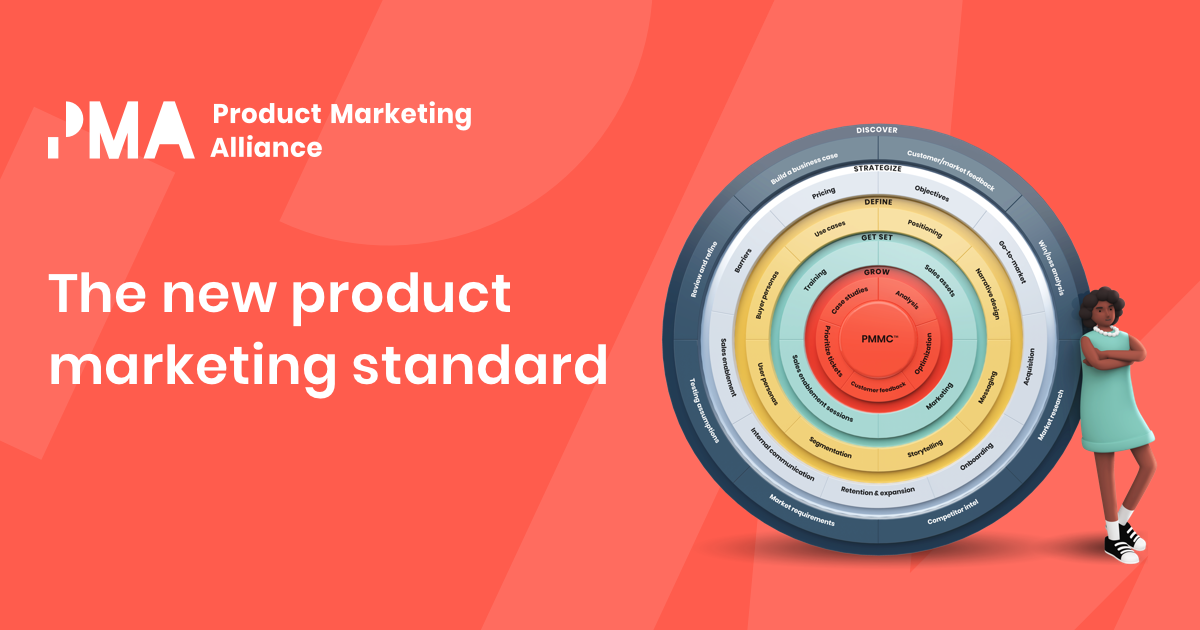As a marketing or product professional, there’s one thing you need to resist: The temptation to make decisions based on a whim, or instinct. Failing to test your assumptions could mark the beginning of a very slippery slope.
To help you make more sensible and strategic decisions, it's worth turning to the 5c’s of marketing. Particularly suited to small or medium-sized businesses, 5c analysis has garnered fans from many corners of the business world thanks to its simplicity and ease.
But what is 5c analysis, and which questions do you need to ask to gain more knowledge about your business? Let’s take a look.
What are the 5 C's of marketing?
Unsurprisingly, the 5c model is based around 🥁… 5 fundamental elements, with each area directly linked to your business model.
These are:
- Company
- Collaborators
- Customers
- Competitors
- Climate/Context
Assessing this quintet will stand you in good stead to gain an overarching understanding of the essential elements of your business.
How to approach each of the 5 C's
To help you understand more about what each of the 5 C's means, let's break them down and think about the role they play in refining your wider marketing strategy:
- Company:Analysis: Assess the company's strengths, weaknesses, capabilities, and resources. Consider factors like financial performance, brand reputation, product portfolio, and core competencies.Action: Use this understanding to leverage strengths and improve weaknesses, aligning strategies with company goals and capacities.
- Customers:Analysis: Understand your target market's needs, preferences, behaviors, and demographics. This involves segmenting the market and identifying key customer segments.Action: Tailor your products, messaging, and campaigns to meet customer needs effectively, enhancing customer satisfaction and loyalty.
- Competitors:Analysis: Identify current and potential competitors. Evaluate their strengths, weaknesses, market positions, and strategies.Action: Develop competitive strategies to differentiate your offerings and gain a market edge, such as through unique value propositions or innovative features.
- Collaborators:Analysis: Consider partnerships and alliances with suppliers, distributors, and other stakeholders who can help you achieve your marketing goals.Action: Foster strong relationships with collaborators to ensure smooth operations, enhanced distribution, and added value to your customers.
- Climate/Context:Analysis: Examine the external environment, including economic, technological, cultural, and regulatory factors that can impact your business.Action: Stay adaptable and proactive in responding to changes in the external environment, ensuring your strategies remain relevant and effective.
What is 5C Analysis?
Now we've established what each of the 5 C's are, let's take a look at how to conduct a thorough 5C analysis.
In short, 5c analyses are used by companies to evaluate and understand potential challenges they may have to face in the future. By completing the process, you’ll be able to identify which areas of your business are working well – as well as areas for improvement before acting on these pros and cons.
Remember, informed decisions lead to fewer mistakes, which generally speaking, will have a more lucrative outcome for your organization.
Asking the right questions forms a huge part of completing an effective 5c analysis. But what questions do you need to ask to get the most from the process? Let's take a look at some of the most important questions you'll need to ask for each for the 5Cs.
Company questions
Before you turn your attention to external factors, you need to understand your own business.
Ask yourself questions such as:
- What does your business sell?
- What are your main products?
- What’s your USP?
- Why are your customers compelled to purchase from your company?
- Where do you gazump your competitors?
- Where can you improve?
- What are the common perceptions of your business?
- Where would your business benefit from an investment?
- Which areas of your business would be sacrificed if needs be?
- Have you set goals for your business?
You may find yourself flying through these Qs without a problem, but if you’re struggling, don’t sweat it; take a step back and complete a SWOT analysis for your business, (PMA members can download our super-handy SWOT template 😉), then come back to the 5c analysis further down the road.

While self-criticism can be difficult, picking out imperfections and focusing on flaws will help you understand and act upon areas where you’re underperforming. Failing to swallow your pride not only deems the exercise ineffective, but also opens the door for your rivals to swoop in and get the upper hand.
After you’ve answered these questions, suppress your eagerness to push ahead. Instead, reflect on how your answers made you feel. Using your emotional responses, set targets for short and long-term periods.
For example, if you’re upset by how your business is perceived, which methods will you use to alter future perceptions? That said, don’t fall into the trap of taking everything personally and acting on raw emotion - it’s all about striking a balance.
Collaborator questions
After considering your company, it’s time to switch your focus to anyone you collaborate with; this may be an individual or another company.
Make a list of each of your collaborators noting their main point of contact, in addition to information such as email addresses and telephone numbers.
Questions about your collaborators may include:
- Who’s in charge of day-to-day operations at the company?
- Do you have a partner that helps you to run the company?
- Are there investors or stakeholders within your company?
- Who manufactures, markets, and distributes your company’s products?
- When you ship products, which company do you use?
- Are there any external workers hired by the company, such as freelancers or contractors?
- Do you hire a social media executive to create and publish content for your social media accounts?
- Are there any external distributors of your product?
- Who assists with marketing and/or advertising?
- Is there a Copywriter or Content Writer writing company material for you?
- Who built your company website, and where is the domain registered?
- Who provides your company with financial advice?
This part of the 5c analysis not only brings to light the full extent of how many people it takes to run your business, but it also allows you to pinpoint who is responsible for particular tasks, allowing you to hold particular people accountable for key areas within your setup.
You may also identify a collaborator who you don’t think is contributing effectively. This presents an opportunity to source a replacement for your team who can perform more efficiently.
Customer questions
Cliches aside, every product marketer needs to understand the customer’s needs come first. After all, without a customer base, your product won’t be shifting anytime soon.
Not only do you need to establish who your customers are, but also how your product aligns with their requirements. It’s not just about generating the initial sale; you want to encourage them to come back for more and build a loyal customer base.
If you understand your customers, this can help you A) develop your product to hone in on what they want, rather than what you want to give them, B) promote it effectively, and C) incorporate messaging that’ll resonate and drive a positive response.
There may be some instances where your target audience comprises more than one segment, in which case, consider the following:
- Who is your ideal customer?
- Who are your target personas?
- Which people are buying your product, currently?
- Which are your most popular products? Comparatively, which aren’t selling well?
- According to your reviews; which products have been well received? Have any been the subject of negative reviews?
- According to analytics, which pages do customers visit frequently on your website?
- What do customers find interesting or uninteresting about your product or service?
- Is there a particular feature users praise more than others?
- How do you liaise with your customers?
- Are your customers loyal to your brand, or are your churn rates high?
- Have you noticed any trends when running promotional campaigns?
- If your customer wants more information about your product or service, where do they register their interest?
- Why does your customer choose to buy your product, instead of your competitors’?
- Has your customer identified any areas for improvement?
The insights gained by asking these questions can be used to develop a clear cut understanding of your customer, with their answers painting a picture of why they’ve decided to buy your product, as well as any practical steps you can take to make your product even better.

However, getting an in-depth understanding of your customers isn’t straightforward, by any means. Many companies attempt to gain an understanding of their customers and encounter difficulties, so don’t be disheartened if you find yourself in the same situation.
That said, if you’re lucky enough to gain the insights you need, this information can be pivotal in gaining a competitive advantage over other rivals within your industry.
Finally, it’s important to remember customer trends will never remain the same. So, when you learn new information about your customer, revisit your analysis and make the necessary amendments to your strategy.
Advanced customer analysis framework: The trinity model
While asking the right questions forms the foundation of customer analysis, implementing a systematic approach to gathering and synthesizing customer insights can transform your 5C analysis from surface-level observations to actionable strategic intelligence.
Laurence Savin, formerly a Senior PMM at Uber's B2B division, has developed an effective framework that combines multiple research methods to create what he calls a "trinity model" of customer understanding. This approach has proven exceptionally useful for businesses looking to move beyond basic demographics and truly understand their customers' value perceptions.
The multi-method research approach
Start with customer interviews – but here's the key: they don't need to be formal or large-scale. "I really love the idea of going just to one or two customers every week," Savin explains. "Just keeping your finger on the pulse, having informal conversations is really powerful." This continuous touchpoint approach ensures you're never too far removed from evolving customer needs.
Next, leverage internal surveys to understand how your own teams perceive and interact with customers. Send a simple Google form to different departments asking how they use existing tools, what metrics they track, and what customer insights they feel are missing. This cross-functional perspective often reveals blind spots in your customer understanding.
Don't overlook desk research – academic studies and industry reports provide theoretical frameworks that can validate or challenge your assumptions. With tools like ChatGPT and Claude, much of this can be automated. There's substantial academic thinking on customer behavior that can inform your practical approach.
Finally, ensure strategic alignment by connecting all customer insights to your product strategy and long-term business direction. Customer analysis in isolation is less valuable than analysis that directly informs strategic decisions.
The trinity model for customer value perception
The framework centers on three fundamentally different but interconnected dimensions:
- Identity – Understanding who your customers are as people, beyond just their job titles or company sizes.
- Thoughts – What customers say when you ask them directly about their needs, preferences, and pain points.
- Behaviors – What customers actually do, which often differs from what they say (their revealed preferences).
"They're three fundamentally different things," notes Savin, "but when looked at together, it gives you a really interesting picture that helps you define value perception."
This trinity approach is particularly powerful because it acknowledges that customers aren't always fully aware of their own needs or may not articulate them clearly. By triangulating identity, stated preferences, and actual behaviors, you can uncover insights that single-method approaches miss.
Implementing advanced customer analysis
To put this framework into practice:
- Schedule weekly informal check-ins with 1-2 customers
- Run quarterly internal surveys to capture cross-functional customer insights
- Maintain a repository of relevant academic and industry research
- Create a simple tracking system that maps customer insights to your product roadmap
- Look for patterns where customer identity, thoughts, and behaviors align or diverge
This systematic approach to customer analysis within the 5C framework ensures you're not just collecting data, but building a nuanced understanding of how customers perceive value. And this is the foundation for effective positioning, messaging, and strategic decision-making.
Competitor questions
Success doesn’t only hinge on how much you know about your own company. You’ve also got to conduct a competitive analysis to learn all there is to know about who you’re up against.
As well as using competitive intel tools, you also need to ask yourself key questions about your competitors, starting with:
- Which companies are you competing with within your industry?
- Are your competitors new to the scene, or are they established? Or both?
- In comparison, does your company’s product fall short in any areas, when compared to your competitors’?
- Read their company reviews to identify their strengths and weaknesses; the feedback can inform your decision making.
- Is there a particular type of content being used by your competitors that’s been particularly well-received? If so, could you consider something similar in your content plan?
- How are they attracting customers to their brand?
- What USPs does your product have to set you apart from other competitors?
- Which personas are being targeted by your competitor?
- Are they well established on social media platforms?
- What do they do that’s different from you?
This is a fundamental stage of the 5c analysis; after all, how can you be expected to compete if you don’t know who you’re competing against? When you know about your competitors’ intricacies, this allows you to exploit their weaknesses and nullify their threat.
Climate/Context questions
Sometimes, you do everything in your power to bring success to your company, only for external factors to conspire against you.
Whilst considering the climate you’re operating in, you need to pay attention to external factors that have the potential to impact your business operations. This may include changes in the law or emerging technologies. Ask yourself:
- Are there viewpoints that could be deemed controversial, insensitive, or unpopular?
- Has the economy changed? If so, how will this influence your customers’ buying habits?
- If there are innovations that have come to market, should they be deemed a competitor? If so, how can you amend your strategy to counteract its impact?
- Upon the introduction of new laws and regulations, consider how new legislation could A) hinder your current practice, or B) open up potential new avenues for your business.
- Are there any cultural references that could be used to guide your product’s messaging and/or marketing campaigns?
These questions will give you an indication of the current climate and which direction the market is heading, and reduce the risk of encountering avoidable problems.
American department store Sears is the perfect example of why you should always pay attention to the climate you’re operating in. Despite customers making their preference for online shopping known, Sears failed to embrace their customers’ longing for the company to shift towards online retail.
With more people opting to shop online amid the coronavirus pandemic, the future of Sears is looking increasingly bleak, with their refusal to take market trends a huge contributor to their downfall.
Add Sears’ reluctance to invest in its existing stores into the mix, and it makes for a pretty sorry story, given the retailer was once one of the leading stores in the US.
5C analysis vs SWOT: Choosing the right framework for your situation
You've mastered the 5C framework, but how do you know when it's the right tool versus other strategic frameworks like SWOT? The choice isn't always obvious, and selecting the appropriate framework can mean the difference between executive alignment and organizational gridlock.
The framework selection challenge
Consider this scenario, shared by fractional CMO, Liza Adams, in her PMM Summit keynote:
A product marketing team faced a critical decision about market expansion. The CEO championed healthcare "because there's a huge market opportunity there." The CFO insisted on manufacturing due to "the highest growth rate." Meanwhile, the CPO advocated for retail because "it better fits with our product roadmap."
"They were all individually right," Adam's recalls, "but just for their very specific point of view or parameter."
This situation perfectly illustrates why framework selection matters. While SWOT analysis might have reinforced each executive's existing bias by focusing on internal strengths and external opportunities, the team needed a more comprehensive approach.
When to use 5C analysis
The 5C framework excels when you need:
- Holistic market understanding: When entering new markets or launching new products.
- External focus: When competitive dynamics and customer needs are rapidly shifting.
- Strategic planning: When developing long-term positioning and go-to-market strategies.
- Stakeholder alignment: When you need a structured way to evaluate multiple perspectives.
In the executive alignment scenario, the product marketing team chose a 5C-inspired approach, creating evaluation criteria that encompassed:
- Market size and growth (Context)
- Competitive intensity (Competitors)
- Customer fit and needs (Customers)
- Internal capabilities (Company)
- Partner ecosystem strength (Collaborators)
When SWOT analysis is more appropriate
SWOT analysis works better for:
- Quick situational assessments: When you need rapid analysis for tactical decisions
- Internal focus: When organizational capabilities are the primary concern
- Project-level planning: When scope is limited to specific initiatives
- Resource allocation: When deciding where to invest limited resources
The heat map approach: Combining framework insights
The most sophisticated practitioners don't choose one framework over another. They adapt and combine them. Liza Adam's suggests creating a heat map that visualizes how each market segment performs across multiple criteria, essentially merging 5C's comprehensive view with SWOT's evaluative approach.
This heat map allows us to see how each one of these segments stack up against each other. The visual comparison enabled the executive team to move beyond individual perspectives and make a data-driven decision.
A practical framework selection guide
Ask yourself these questions to choose the right framework:
- What's your primary challenge?
- Market entry or expansion → 5C analysis
- Internal optimization → SWOT analysis
- What's your time horizon?
- Long-term strategy (6+ months) → 5C analysis
- Short-term tactics (< 6 months) → SWOT analysis
- Who are your stakeholders?
- Cross-functional teams with different priorities → 5C analysis with heat mapping
- Single department or focused team → SWOT analysis
- What's your desired outcome?
- Comprehensive market strategy → 5C analysis
- Go/no-go decision → SWOT analysis
Remember, the best framework is the one that drives alignment and action. Sometimes that means using 5C's structured approach, sometimes SWOT's simplicity, and sometimes creating a hybrid that serves your specific needs.

5C Analysis Example - Walmart

If you're unsure about where to start your own 5C analysis, don't worry. To help, here's a example of an effective analysis of the well-known retail giant, Walmart.
Company
Analysis:
- Strengths: Walmart is one of the world's largest retailers with significant financial resources, a vast network of stores, a robust supply chain, and strong brand recognition. They offer a wide range of products at competitive prices.
- Weaknesses: Despite its strengths, Walmart faces challenges such as thin profit margins, controversies related to labor practices, and a perceived lack of personalized shopping experience.
- Capabilities: Walmart has capabilities in logistics, data analytics, and supply chain management, enabling them to maintain low prices and efficient operations.
Action:
- Leverage its logistical expertise and financial resources to further enhance its e-commerce platform.
- Continue investing in technology to improve customer experience and operational efficiency.
- Address weaknesses by improving labor practices and enhancing customer service to build a more positive brand image.
Customers
Analysis:
- Target market: Walmart serves a broad customer base, primarily focusing on price-sensitive consumers looking for value deals. Their customers include families, budget-conscious individuals, and small businesses.
- Needs and preferences: Customers seek affordability, convenience, a wide product selection, and one-stop shopping.
Action:
- Continue offering competitive pricing and a vast product selection.
- Enhance the online shopping experience to cater to the growing trend of e-commerce.
- Introduce personalized promotions and loyalty programs to increase customer retention and satisfaction.
Competitors
Analysis:
- Main competitors: Walmart’s primary competitors include Amazon, Target, Costco, and regional/local retailers. Each competitor offers different strengths, such as Amazon’s vast online presence, Target’s focus on style and customer experience, and Costco’s membership-based bulk pricing.
- Competitive strategies: Competitors focus on differentiating themselves through superior customer service, unique product offerings, and enhanced digital platforms.
Action:
- Strengthen Walmart's online presence to compete with Amazon.
- Enhance in-store experience to differentiate from other physical retailers like Target.
- Utilize data analytics to offer personalized shopping experiences and targeted marketing campaigns.
Collaborators
Analysis:
- Suppliers: Walmart collaborates with a vast network of suppliers worldwide, maintaining strong relationships to ensure product availability and cost-efficiency.
- Distribution partners: Walmart's distribution network includes its own logistics and third-party delivery services for online orders.
- Technology partners: Collaborates with technology firms to enhance its online and in-store shopping experiences.
Action:
- Continue building strong relationships with suppliers to ensure competitive pricing and product availability.
- Invest in technology partnerships to further develop e-commerce capabilities and improve supply chain efficiency.
- Explore strategic alliances with other companies to introduce innovative products and services.
Context
Analysis:
- Economic factors: Economic downturns can increase Walmart’s sales as consumers look for cost savings. Conversely, economic growth can shift consumer spending to higher-end retailers.
- Technological factors: Rapid advancements in technology impact Walmart’s operations, requiring continuous investment in digital transformation.
- Regulatory factors: Compliance with labor laws, environmental regulations, and trade policies is crucial for Walmart’s operations.
- Social factors: Changing consumer preferences towards sustainable and ethical products influence Walmart’s product offerings.
Action:
- Stay adaptable to economic changes by offering a mix of budget-friendly and premium products.
- Invest in technology to enhance online and offline shopping experiences.
- Ensure compliance with all regulatory requirements and proactively address any potential issues.
- Incorporate more sustainable and ethically sourced products to align with consumer preferences.
Want to learn more?
Whether you’re a startup battling incumbents or an established company that needs to remain a leader, knowing how to work with analysts will make product marketing that much easier.
Led by expert and Product Marketing Leader at Atlassian, Daniel Kuperman, the Analyst Relations Certified: Masters course is filled to the brim with awesome insights, informative and handy coursework tasks, and actionable steps you can take to completely revolutionize how you approach your relationships with your analyst team to give you that advantage.
This course will help you to confidently:
👊 Understand the different approaches to analyst relations based on your company's stage and team size.
🔥 Create a comprehensive plan of attack to engage with the right analyst firms.
🚀 Leverage best practices to succeed at analyst briefings and inquiries.
🤑 Ensure your company is well-represented in analyst reports and communications.
So what are you waiting for?
Enroll today

















 Follow us on LinkedIn
Follow us on LinkedIn





.svg?v=7919bee89c)